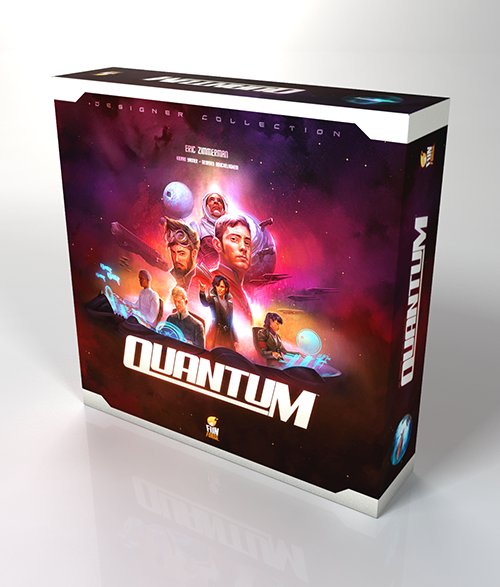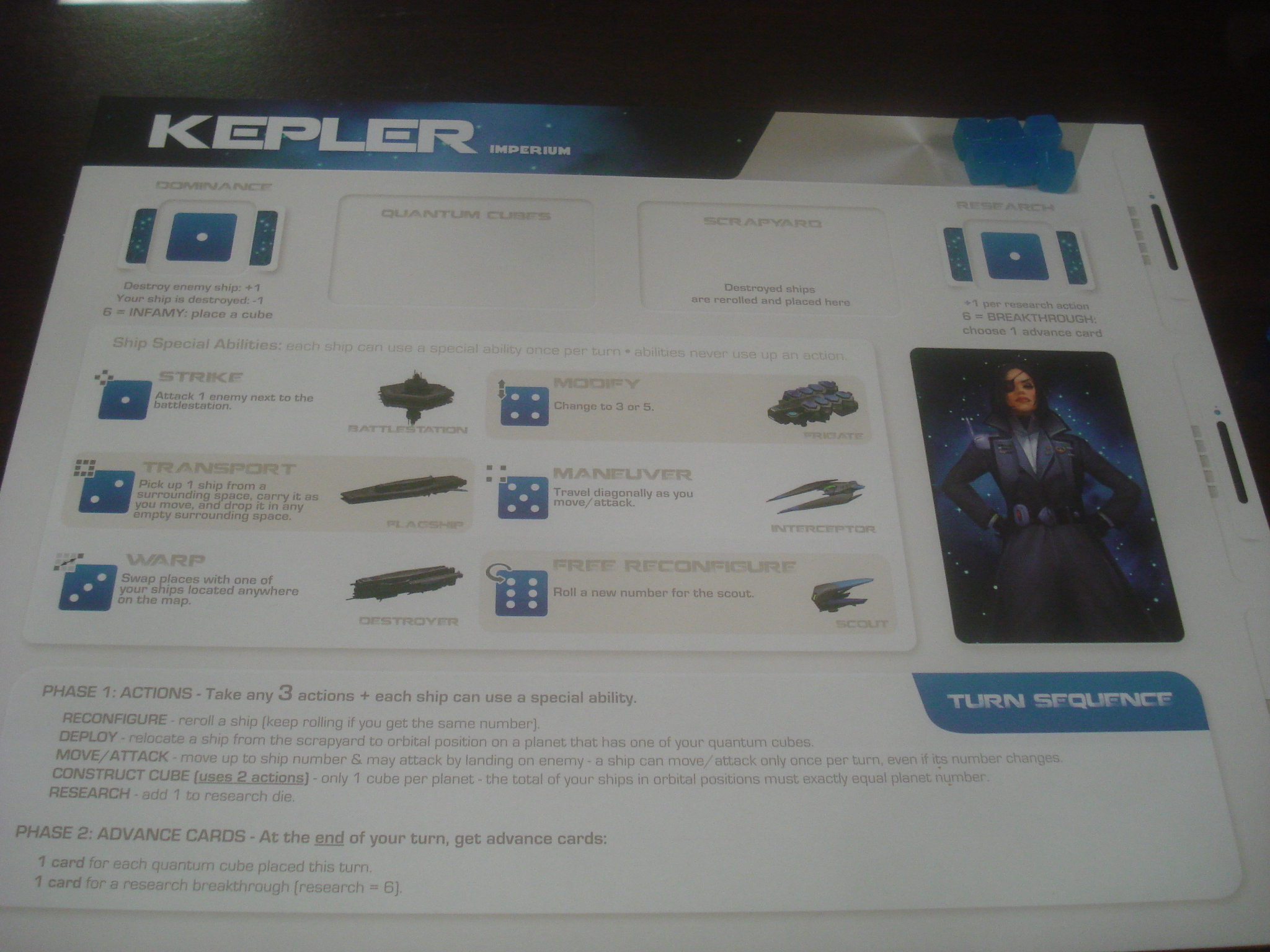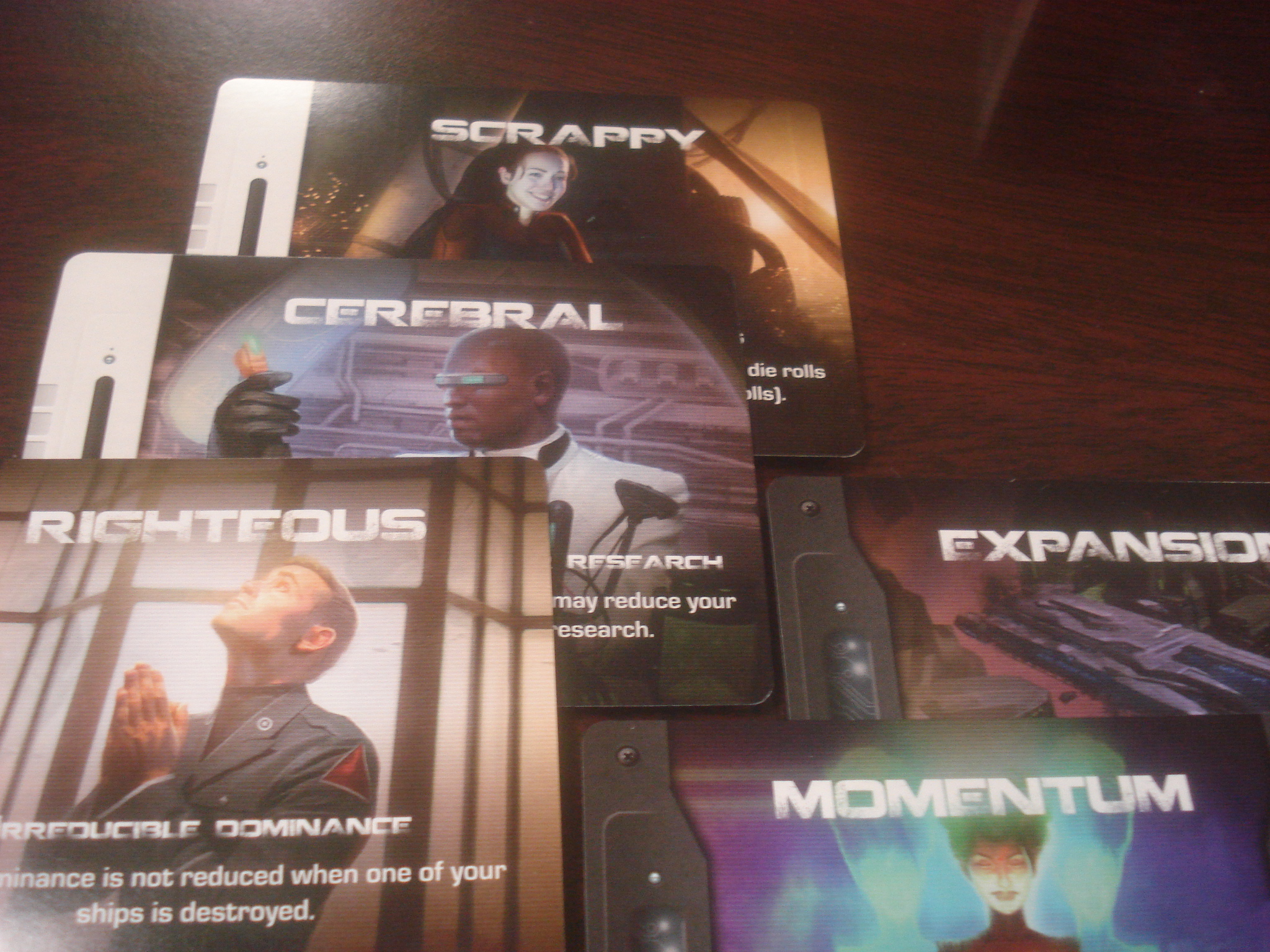| Publisher | Funforge |
| Design Credits | Eric Zimmerman, John Sharp |
| Art Credits | Kieran Yanner, Georges Bouchelaghem, Funforge Studio |
| Proofing Credits | Nathan Morse |
| Game Contents | 24 map tiles, 28 dice and 28 quantum cubes tokens (seven each in four player colors), two combat dice, 22 gambit cards, 31 command cards, four command sheets, rulebook |
| Guidelines | Abstract space-colonization strategy dice game |
| MSRP | $56.00 |
| Reviewer | Andy Vetromile |
At the risk of sounding judgmental, if you travel the length and breadth of the galaxy looking for planets to conquer, maybe the best strategy doesn’t involve sucking the life out of what you discover. That system seems to work for the remaining members of humanity’s Stellar Council, though: Long after the destruction of the Earth (by way of this same technology), they want to dominate the spaceways by establishing base-generators at each world they encounter. Four factions try to reclaim glories past, and this is how Quantum begins.
The object of the game is to be the first to place all one’s quantum cubes.
Two to four intrepid galactic settlers start the game with their own board, some dice, and a set of quantum cubes. In their midst is the playing area, a grid of squares with planets. Each of these has a number from 7 to 10 and preprinted spaces for placing colonies on the surface and ships in orbit. There are two phases to every player’s turn, and in the first he takes three actions. He can deploy spaceships (the dice), move and/or attack, increase his research rating (also tracked with a die), reconfigure a ship (roll it to become another ship), or establish a base.
Ships are rated by the number they show – lower numerals are more powerful but move slower. A 1 is a battlestation, for example; it tugs along at one space per move, but lower totals win fights so it destroys most anything drifting within range. Each class of ship also has a power that costs nothing to use – the destroyer (a craft with a 3) has the ability to swap places with another ship in its fleet, and a frigate (showing 4) can raise or lower itself to a 5 or 3. Combat starts when a ship moves onto an opponent’s space; both roll a second die and add it to their ship’s number, and the lower total wins. It may go against conventional wisdom but the attacker sacrifices nothing if he loses. When the attacker wins the defender is sent to its owner’s shipyard (a space on the player’s board) where it is rerolled, becomes a new ship, and awaits redeployment. The defender also drops one dominance point while the aggressor gains one. These are tracked by another die on the player boards. When someone has six dominance he places a new quantum cube anywhere on the map.
Not every turn is driven by combat; a race to exploration is every bit as feasible (and a much faster, direct way to achieve victory). Each square of the board contains a planet, and ships enter, navigate, and leave their eight-space orbits and move from one section of the board to the next. If you set up craft adjacent to the world (orthogonally, as opposed to sitting in one of the corners of the square), they can establish a base there. The ship dice must show the planet’s number exactly – for example, a “9” means that’s the total the dice-ships are gunning for – in order to create a colony.
Helping in either enterprise are the advance cards. The black gambit cards offer important, one-use effects like adding a new dice-ship to one’s fleet or taking an extra action; the white command represent personnel whose qualities – righteous, cruel, scrappy – give a permanent bonus to the owner’s gameplay. Cards can be claimed when the research die reaches six or whenever one places a quantum cube. The first player to employ all his cubes across the galaxy wins the game.
The idea of dice as ships is nothing new, but these are nice six-siders. Semitranslucent, they’re slightly bigger than what you probably expect. The quantum cubes are small – almost distressingly so, easy as they are to lose if you drop them – but they’re awfully pretty and have that futuristic look about them, assuming everything in the future is frosted, hollow plastic. The planet squares are large and easy to read, though the orbital spaces around them are somewhat faint, and the rulebook is a nice bit of graphic design as well. The character portraits and artwork on the cards are to die for, with a couple of pieces that aspire to greatness.
It’s nice to see gaming can be a bloodless affair, depending on the temperament of one’s group. Take the combat away from this enterprise and you’ve removed a major element of Quantum’s play, but what remains is still an interesting chess game wherein players seek to outmaneuver one another to get their cubes placed. Planets have limited spaces for colonization, so it’s important to get there first or concentrate the fleet somewhere no one else has yet shown interest in. The variable setups (the board need not be laid out in the standard three-by-three arrangement) keep every game fresh and allow for further customization if the publishers want to pump out a sequel or two. Powers for each faction might be nice, since the rulebook gives a thumbnail of each group but there’s no functional difference between playing the Kepler Imperium and the Andromeda Confederation.
Hardcore wargamers might not see the value here. Quantum is partly about combat, yes, and the streak of strategy that cuts through its middle is to be appreciated even with its simplistic shortcuts. But this is a game meant to be played in about an hour, and while every move is an important one it’s not going to engage the blitzkrieging part of the brain that makes conquest so appealing in most galactic struggles. Rather, it’s a dance wherein one cannot throw all one’s weight behind any one strategy. The game offers all manner of flexibility for the rules of play and the pieces, and putting all that to best use is the cerebral quandary Quantum players find themselves in.



